Making New Orleans King Cake
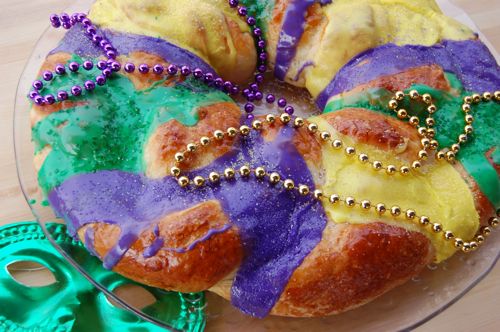
Though certainly not as refined as their continental cousins, king cakes are sweet, garish pleasures. I confess I was surprised at how good this recipe was. Having eaten nothing but dried out mail-order king cakes for years, this one was tender and delicious. The liquid butter yields a slightly denser crumb than a traditional brioche dough would, though I’d still be interested to try this using my standard brioche dough, since I think that would amp up both the color and the flavor (of the interior). Still there’s no beating this recipe for maximum return on a minimum investment of time and effort. Begin by assembling your ingredients. Sift your flour into the bowl of your mixer:
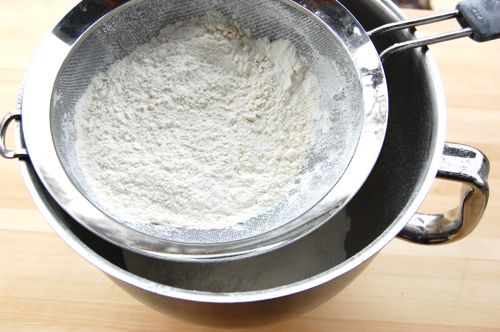
Add in all your dry ingredients and stir with the beater (paddle) to distribute them.
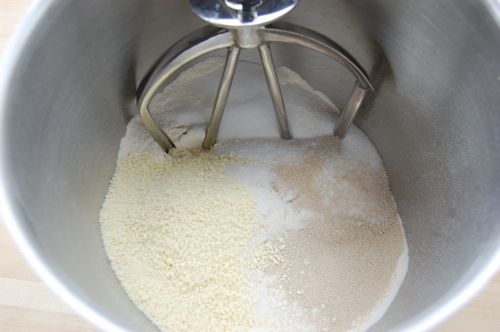
Whisk together the wet ingredients and melted butter…
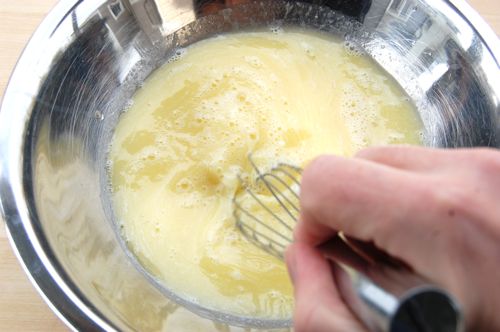
…then add to the dry ingredients.
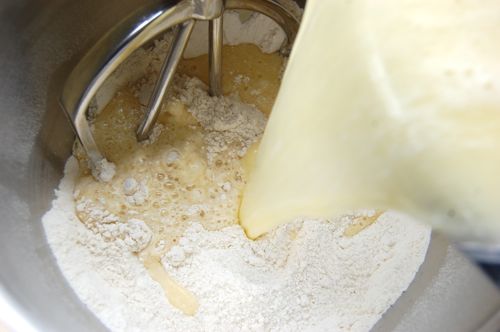
Stir until everything is moistened, then switch to the dough hook.

Knead for about 8 minutes until the dough comes together in a slightly sticky ball. If it’s too sticky, add a little more flour, but remember that the finished dough will be slack and greasy no matter what.
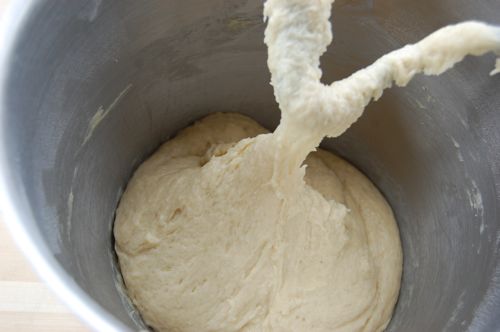
Scrape it into a oiled bowl, cover it with plastic and let it rise for about an hour.
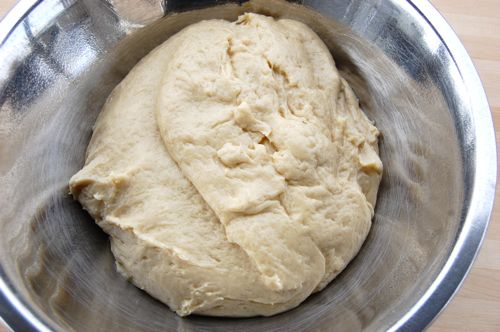
It will be roughly doubled in size.
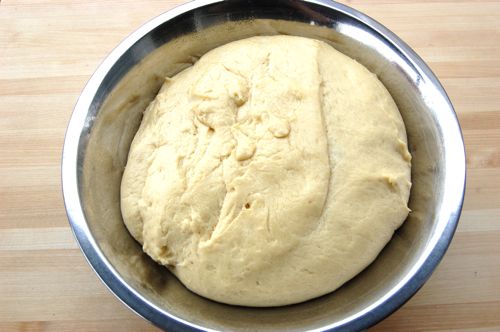
Turn it out onto a well-floured surface…
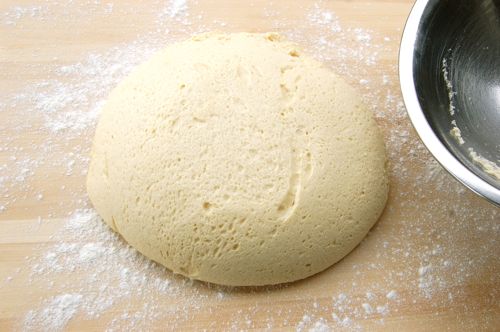
…and roll.
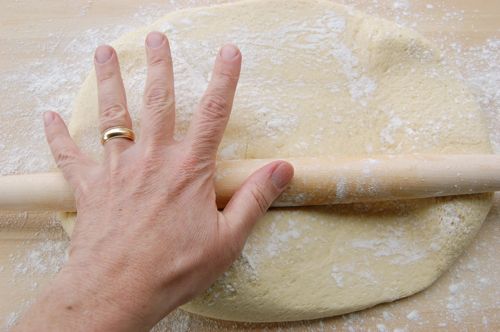
You want the piece to be about 18″ long by about 12″ wide.
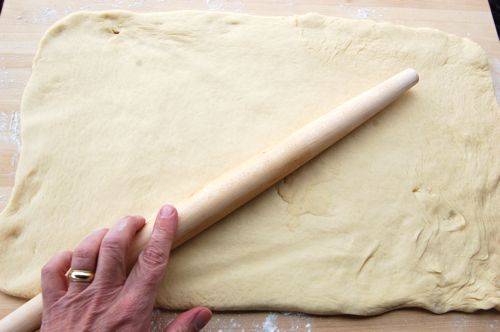
Apply the cinnamon sugar.
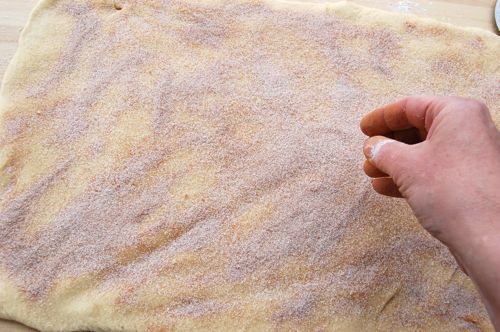
Then with a pizza cutter, slice the dough sheet long ways into 4″ strips. If you don’t want to have to worry about braiding your king cake, you can just roll the whole thing up (long-ways) if you prefer.
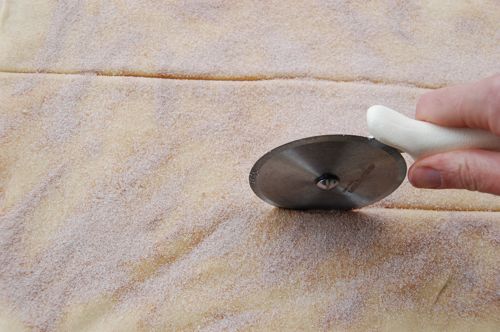
Fold the pieces over on themselves…

…and pinch them shut. Here I should say that cinnamon sugar isn’t your only filling option here. A thin stripe of pastry cream or frangipane can be spread down the middle of each strip, then enclosed. Some people use cream cheese, but I’d discourage that unless you were using a sweetened cream cheese filling à la cheese Danishes. I’m told cheese and cherries are popular. Oh, and did I mention that this is the time to add your dried fava bean or little plastic baby?

Once the strips are ready, squeeze the ends together…
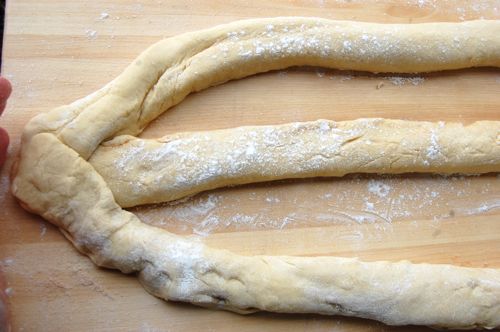
…and braid them. Gents, ask a woman in your life to help you with this part if you don’t know how, it’s really pretty easy.
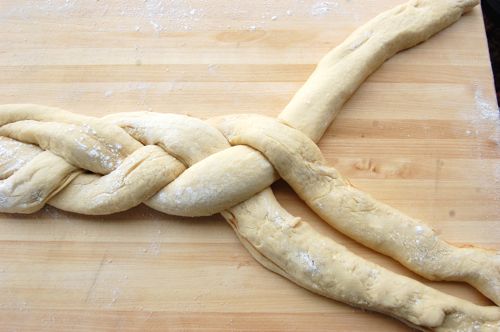
Bring the ends around to form a circle and squeeze the ends together. I’m not a great braider as you can see, but an imperfect braid will still make a lovely cake.

Slip the cake onto a piece of parchment and the piece of parchment onto the back of a sheet pan or a cookie sheet without a lip. Why? Because the cake ends up being bigger that the pan when it’s baked and you need to give it room to expand. Now paint the cake with egg wash and proof it for about an hour until it’s puffy.
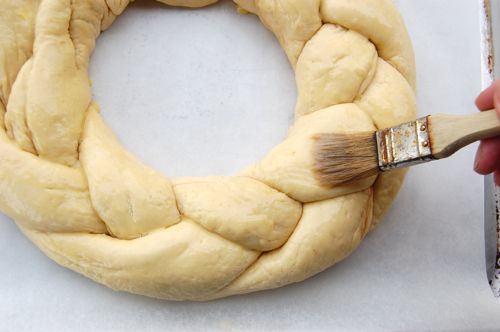
Meanwhile, preheat your oven to 350. Once the cake has proofed you have a couple of options. You can either put the cake into the oven on the pan or cookie sheet, or, if you have a pizza stone in your oven (I always do) you can slip the cake off the pan and bake it directly on the stone. For a cake this big I prefer the latter method. The idea in a nutshell is to insert the pan almost all the way into the oven with the cake and parchment still on it, tip the pan forward slightly so the far edge of the pan is touching the far edge of the stone, and then with a slight jerk, pull the pan out, allowing the cake and parchment sheet to drop onto the stone. You can practice this with a cold oven using a loaf of baked bread or some towels. It’s a very easy trick to master. Also, you can just make a smaller king cake.
Brush it with more egg wash before it goes in. Bake for 20 minutes, rotate the pan, and bake about another 15 until it looks about like this. Sort of ugly, yes? But that’s what happens when you bake up a very yeasty, quick-raised bread. You get lots of expansion. The newly exposed areas don’t have egg wash on them, which means they don’t brown very well. But that’s why God created icing.
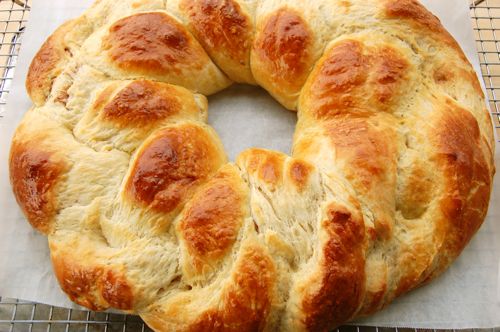
While the cake is cooling on a rack, make your icing and color the various batches yellow, green and purple. When you’re ready to ice, pull out the parchment sheet, then start icing with your lightest color, the yellow. Don’t be bashful, just dump it on there and let it run:

Before it sets up, sprinkle on some colored sugar. I do like-with-like, but then I’m uptight.
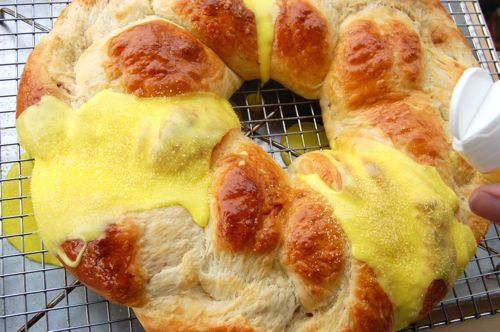
Now the green…
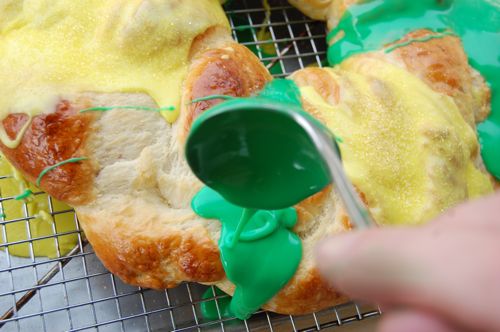
…and sugar…
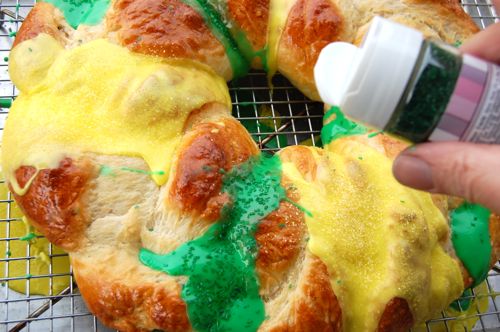
…and finally the purple (and sugar).

The colors will set up in about ten minutes, after which you can move the cake, gently, to a large platter and decorate as you wish.
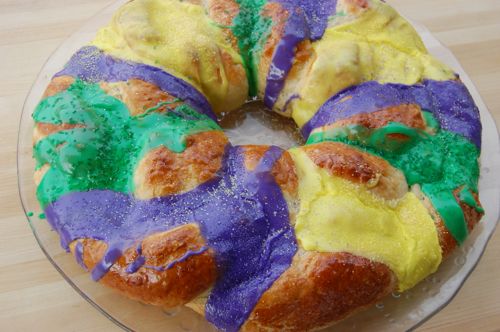
Laissez le bon temps rouler!
Wow! This is really fancy. Every year I tell myself I am going to make a king’s cake, and every year I procrastinate. Next year I am going to do it, but I think I’ll use your brioche recipe. I made sweet rolls with it and they were so good.
Wow. Totally gaudy and yet strangely appealing. I’ve never seen a New Orleans-style King Cake before, thanks for the tutorial.
My pleasure, Julie!
Beautiful Cake!
Thanks Twyla!
Looks kinda poisonous, but I am pretty sure it tastes really good when eaten with eyes closed 🙂
Indeed! Maybe it should be called the king SNAKE instead. How does that rhyme go? Purple on green is peachy-keen, purple on yellow kills a fellow? It’s something like that….www.floridasnakes.net/coralsnakes.htm
I love that it’s braided. Great tutorial!
Thanks, Sara!
Great king cake–as for the colors–if it ain’t gaudy it ain’t really a king cake!
I never put a filling or swirl in mine, and it is, frankly, a little boring (though my grandkids actually like the blandness, and, of course, love the colors!). You’ve inspired me to do something different–next year, that is! Come check out my St. Pat’s cookies–grandkids loved ’em.
I certainly will! Thanks Nancy!
I made a king cake this year – but did it the cheaters way. I used store-bought bread dough ( I know! I know!) But it came out beautiful, and tasted darn good. Next year I will do it the right way!
Ah, now THAT’s the king cake I remember from my childhood. Beautiful, beautiful. Shame I was too lazy to make one this year! (Btw, I came here from Food52. So glad they posted; I’ll be adding you to my feed now!)
Welcome, Amy! Thanks for the note, and I think you’ll be pleased with that recipe when you get around to it next year. I know I was…it turned out far better than I ever expected. I take it you’re from New Orleans or the Gulf Coast?
I truly love the tradition regarding the king cakes! I enjoy eating as they were the most great cakes in the whole world and I truly believe that it tastes differently than usual cakes. Or is this just my belief?
I think they are different in that they are an unusually sweet bread. And where else are you going to find all those crazy colors? Thanks for the comment!
Joe, thank you for this King Cake recipe. I can get a pretty good one at the local bakeries here in Houston, but I have been perusing the internet for a homemade version. I found you via Food52 and I am so glad. Your recipe looks just right, but your photographic instructions are really helpful. I will be saving this for next year.
Thanks, Waverly, and welcome. I think you’ll be delighted with this recipe. As I’ve written several times, it’s far better than I ever expected.
hi joe, can you halve this recipe? i made the cake yesterday and it turned out great, but the cake was ginormous.
You certainly can because you’re right, it’s huge.
I just made this and it turned out beautifully. After a minor error…I forgot to add the yeast to the dough until I had already kneaded it for 5 minutes (I kneaded some into the dough and proofed the other portion with a small amount of water to make a paste, and then kneaded the paste in)…the dough rose beautifully. I don’t have a standmixer so everything was kneaded by hand. It’s a soft dough but a dream to work with in my opinion (must be the butter!). I divided it in two and made one “cake” filled with nutella and dark chocolate chunks. I made king cake “cupcakes” with the other half (with the cinnamon sugar filling) because they’re easier to bring to work. Both were frosted with icing and sprinkles. thank you so much for the recipe…I couldn’t be happier with the results!
Excellent, Emily! So glad it worked for you!
– Joe
I just want to add that I have now made this several times but now I remember to add the yeast when I should :). The dough rises beautifully and is infinitely adaptable. I’ve made it as a regular coffeecake, as morning buns (replacing croissant dough) with almond, citrus and a small amount of cinnamon, and filled with many different types of chocolate. I love this dough…eventually I’ll actually have to try it with dry milk. Thank you again for the great recipe and tutorial!
Wow, Emily, you’ve really gone to town with this dough. That’s fantastic. Everyone needs those go-to recipes that they can turn into all sorts of things. I’m so pleased you found one of yours here!
– Joe
I was just wondering how many servings does one cake serve?
Also, I made a King Cake years before (but can’t find the recipe anymore) and it called for lemon zest. I wonder why it isn’t used in this recipe as I have seen it in many other recipes. Just curious.
Emily said she didn’t use powdered milk, so did she just leave it out or use real milk instead? I don’t know if you know or not. I’m not the biggest fan of powdered milk in general.
But it looks good! Can’t wait to make this again this year!
You certainly can use milk instead of water and powdered milk. No problem. Also if you’d like to add some lemon set by all means do. These cakes are pretty big. It depends on the size of the pieces, but I’d say 16-20.
Let me know if you have any other questions!
– Joe